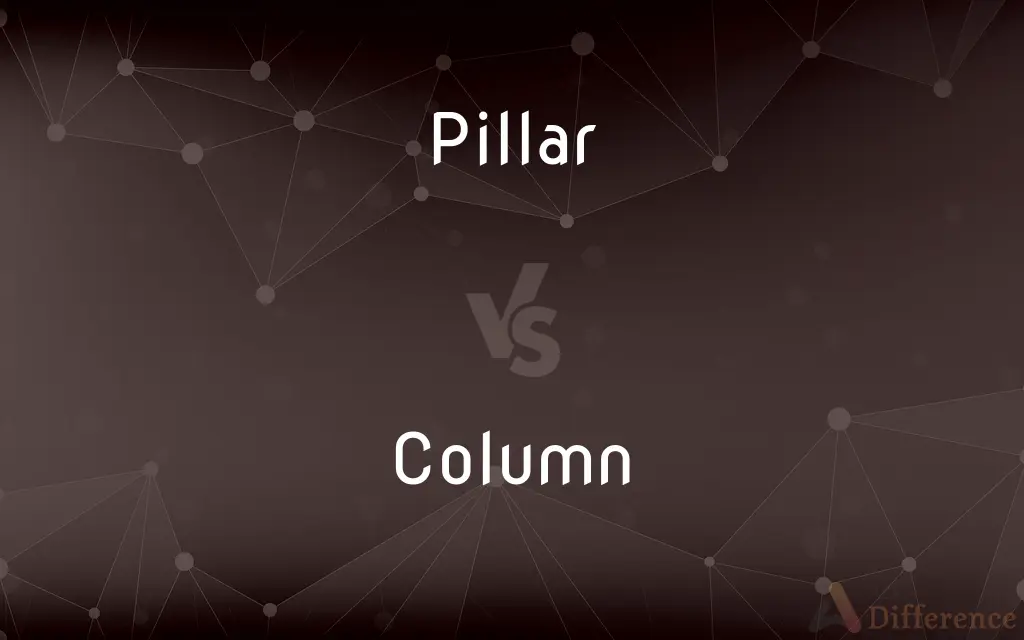Pillar vs. Column — What's the Difference?
By Tayyaba Rehman — Updated on October 3, 2023
A "pillar" is a supportive upright structure, often used metaphorically, while a "column" is a vertical architectural element, typically cylindrical.

Difference Between Pillar and Column
Table of Contents
ADVERTISEMENT
Key Differences
A "pillar" commonly denotes an upright structure supporting a building. It can also be metaphorical, signifying strength or foundational support. On the other hand, a "column" is specifically an architectural term, often referring to a cylindrical support.
The term "pillar" carries more than just a physical connotation. It can describe principles, values, or key figures – like saying someone is a "pillar of the community." "Column," while sometimes metaphorical in journalism or data presentation, primarily remains tied to architecture.
You might find "pillar" used broadly across different contexts. In ancient ruins, a "pillar" might be all that remains of a once great edifice. In contrast, a "column" often brings to mind grand structures, such as the columns of ancient Greek temples.
The distinction between "pillar" and "column" becomes crucial in architecture. While both can provide support, columns often have a distinct style, inspired by various architectural orders like Doric, Ionic, and Corinthian. "Pillars" lack such specific categorizations.
In essence, all columns can be pillars due to their supportive nature, but not all pillars are columns. While "column" maintains its architectural essence, "pillar" possesses a versatility that extends beyond mere physical structure.
ADVERTISEMENT
Comparison Chart
Meaning
Supportive upright structure
Vertical architectural support
Usage Context
Both physical and metaphorical
Primarily architectural; occasionally data
Design
General design without specific styles
Often has specific styles like Doric, Ionic
Broader Meaning
Can symbolize foundational principles or strong figures
Mainly tied to architecture
Type
Can be any upright supporting structure
Typically cylindrical
Compare with Definitions
Pillar
A freestanding monument.
The memorial was a solitary pillar.
Column
A vertical division of a page or text.
The article continued in the next column.
Pillar
Something resembling a vertical structure.
The pillar of smoke could be seen for miles.
Column
A vertical set of data.
Input the numbers in the next column of the spreadsheet.
Pillar
A principal or foundational idea.
Honesty is a pillar of our ethics.
Column
A column or pillar in architecture and structural engineering is a structural element that transmits, through compression, the weight of the structure above to other structural elements below. In other words, a column is a compression member.
Pillar
An upright supportive structure.
The old building rested on stone pillars.
Column
A vertical structure usually consisting of a base, a cylindrical shaft, and a capital, used as a support or standing alone as a monument.
Pillar
A person considered as providing strong support.
She was a pillar of strength during tough times.
Column
Any slender vertical support, as of steel or reinforced concrete.
Pillar
A slender, freestanding, vertical support; a column.
Column
Something resembling an architectural column in form or function
A column of mercury in a thermometer.
Pillar
Such a structure or one similar to it used for decoration.
Column
One of two or more vertical sections of text lying side by side in a document and separated by a rule or a blank space.
Pillar
One who occupies a central or responsible position
A pillar of the state.
Column
An arrangement of numbers in a single vertical line.
Pillar
To support or decorate with pillars or a pillar.
Column
A feature article that appears regularly in a publication, such as a newspaper.
Pillar
(architecture) A large post, often used as supporting architecture.
Column
A formation, as of troops or vehicles, in which all elements follow one behind the other.
Pillar
Something resembling such a structure.
A pillar of smoke
Column
(Botany)A columnlike structure, especially one formed by the union of a stamen and the style in an orchid flower, or one formed by the united staminal filaments in flowers such as those of the hibiscus or mallow.
Pillar
(figuratively) An essential part of something that provides support.
He's a pillar of the community.
Column
(Anatomy)Any of various tubular or pillarlike supporting structures in the body, each generally having a single tissue origin and function
The vertebral column.
Pillar
(Roman Catholic) A portable ornamental column, formerly carried before a cardinal, as emblematic of his support to the church.
Column
(architecture) A solid upright structure designed usually to support a larger structure above it, such as a roof or horizontal beam, but sometimes for decoration.
Pillar
The centre of the volta, ring, or manege ground, around which a horse turns.
Column
A vertical line of entries in a table, usually read from top to bottom.
Pillar
(bodybuilding) The body from the hips over the core to the shoulders.
Column
A body of troops or army vehicles, usually strung out along a road.
Pillar
To provide with pillars or added strength as if from pillars.
Column
A body of text meant to be read line by line, especially in printed material that has multiple adjacent such on a single page.
It was too hard to read the text across the whole page, so I split it into two columns.
Pillar
The general and popular term for a firm, upright, insulated support for a superstructure; a pier, column, or post; also, a column or shaft not supporting a superstructure, as one erected for a monument or an ornament.
Jacob set a pillar upon her grave.
The place . . . vast and proud,Supported by a hundred pillars stood.
Column
A unit of width, especially of advertisements, in a periodical, equivalent to the width of a usual column of text.
Each column inch costs $300 a week; this ad is four columns by three inches, so will run $3600 a week.
Pillar
Figuratively, that which resembles such a pillar in appearance, character, or office; a supporter or mainstay; as, the Pillars of Hercules; a pillar of the state.
By day a cloud, by night a pillar of fire.
Column
(by extension) A recurring feature in a periodical, especially an opinion piece, especially by a single author or small rotating group of authors, or on a single theme.
His initial foray into print media was as the author of a weekly column in his elementary-school newspaper.
Pillar
A portable ornamental column, formerly carried before a cardinal, as emblematic of his support to the church.
Column
Something having similar vertical form or structure to the things mentioned above, such as a spinal column.
Pillar
The center of the volta, ring, or manege ground, around which a horse turns.
Column
(botany) The gynostemium
Pillar
Having a support in the form of a pillar, instead of legs; as, a pillar drill.
Column
(chemistry) An object used to separate the different components of a liquid or to purify chemical compounds.
Pillar
A fundamental principle or practice;
Science eroded the pillars of superstition
Column
A kind of pillar; a cylindrical or polygonal support for a roof, ceiling, statue, etc., somewhat ornamented, and usually composed of base, shaft, and capital. See Order.
Pillar
Anything tall and thin approximating the shape of a column or tower;
The test tube held a column of white powder
A tower of dust rose above the horizon
A thin pillar of smoke betrayed their campsite
Column
Anything resembling, in form or position, a column in architecture; an upright body or mass; a shaft or obelisk; as, a column of air, of water, of mercury, etc.; the Column Vendôme; the spinal column.
Pillar
A prominent supporter;
He is a pillar of the community
Column
A body of troops formed in ranks, one behind the other; - contradistinguished from line. Compare Ploy, and Deploy.
Pillar
A vertical structure standing alone and not supporting anything (as a monument or a column of air)
Column
A number of ships so arranged as to follow one another in single or double file or in squadrons; - in distinction from "line", where they are side by side.
Pillar
(architeture) a tall cylindrical vertical upright and used to support a structure
Column
A perpendicular set of lines, not extending across the page, and separated from other matter by a rule or blank space; as, a column in a newspaper.
Column
A perpendicular line of figures.
Column
The body formed by the union of the stamens in the Mallow family, or of the stamens and pistil in the orchids.
Column
One of a series of articles written in a periodical, usually under the same title and at regular intervals; it may be written and signed by one or more authors, or may appear pseudonymously or anonymously, as an editorial column.
Column
A line of (usually military) units following one after another
Column
A vertical glass tube used in column chromatography; a mixture is poured in the top and washed through a stationary substance where components of the mixture are adsorbed selectively to form colored bands
Column
A linear array of numbers one above another
Column
Anything tall and thin approximating the shape of a column or tower;
The test tube held a column of white powder
A tower of dust rose above the horizon
A thin pillar of smoke betrayed their campsite
Column
An article giving opinions or perspectives
Column
A vertical structure standing alone and not supporting anything (as a monument or a column of air)
Column
(architeture) a tall cylindrical vertical upright and used to support a structure
Column
A vertical architectural structure, typically cylindrical.
The temple had ornate columns at its entrance.
Column
A regular article or feature in a newspaper or magazine.
She writes a weekly column on fashion.
Column
A military formation.
The column of soldiers marched forward.
Common Curiosities
Do "pillars" have specific styles like columns?
No, while columns might be Doric or Ionic, pillars lack such specific categorizations.
Can both "pillar" and "column" support weight?
Yes, both are designed to support structures or weight above them.
Can "pillar" and "column" be used interchangeably?
Sometimes, especially in architecture, but "pillar" has broader metaphorical uses.
Is "column" used outside of architecture?
Yes, "column" can refer to vertical divisions in texts, articles in publications, data sets, or military formations.
Does "pillar" have religious connotations?
It can, such as in references to the "pillars of Islam" or biblical references.
Can "pillar" have a metaphorical meaning?
Yes, "pillar" can denote strength or foundational support, such as a "pillar of the community."
Can a "column" be square?
While typically cylindrical, some "columns" might have square or other polygonal bases.
Are there distinct styles of columns?
Yes, columns have styles like Doric, Ionic, and Corinthian, based on their design and origin.
What's an example of "column" in data?
In a spreadsheet, a vertical set of data cells is a "column."
What might a "column" in a newspaper refer to?
It can mean a regular article or feature, often written by the same author.
What's the fundamental difference between "pillar" and "column"?
A "pillar" is a general supportive structure, while a "column" is a specific architectural feature.
How are "pillars" used metaphorically?
A "pillar" can symbolize foundational principles, values, or key supportive figures.
Are columns always structural?
Often they are, but decorative columns might not provide significant support.
Can "column" refer to troops?
Yes, it can denote a military formation, as in a "column of soldiers."
Is a "pillar" always tall?
Not necessarily; it's relative to the structure or context it's in.
Share Your Discovery

Previous Comparison
Filament vs. Fiber
Next Comparison
Cup vs. MugAuthor Spotlight
Written by
Tayyaba RehmanTayyaba Rehman is a distinguished writer, currently serving as a primary contributor to askdifference.com. As a researcher in semantics and etymology, Tayyaba's passion for the complexity of languages and their distinctions has found a perfect home on the platform. Tayyaba delves into the intricacies of language, distinguishing between commonly confused words and phrases, thereby providing clarity for readers worldwide.















































